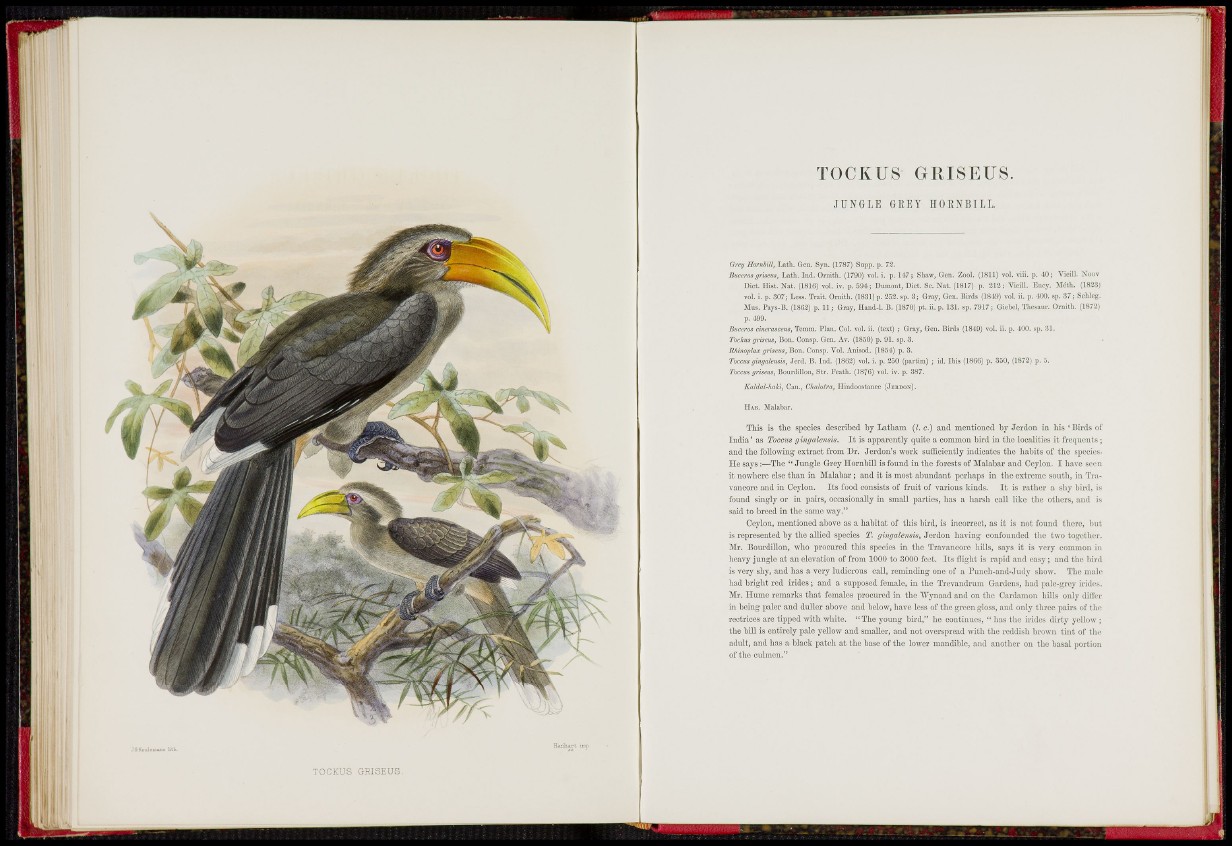
j ; .
! i
i;')!
I ( ^ .
Hatthsrt M^p
TOCKUS GRI8EUS.
J U N G L E GREY EOENBILL.
Grey Hm-nbill, Lath. Gcn. Syn. (1787) Supp. p. 72.
Buceros griseus, Lath. Ifld. Oriiith. (1790) vol. i. p. 117; Sliaw, Gcn. Zool. (1811) vol, viii. p. 40j Vieill. NOUT
Diet. Hist, Nat . (1816) TOI. iv. p. 50-1; Dumont, Diet. Sc. Nat . (1817) p. 212; Vicill. Ency. Muth. (1823)
vol. i. p. 307; Less. Trait. Ornith. (1831) p. 252. sp. 3; Gray, Gea. Birds (IS'IO) vol. ii. p. -lOO. sp. 37; Sclilc^.
Mus. Pays-B. (1862) p. 11; Gray, Hand-l. B. (1870) pt. ii. p. 131. sp. 7917; Giehel, Tliosaur. Ornith. (1872)
p. 499.
Buceros cinei-asccns, Temm. Plan.. Col. vol. ii. (test) ; Gray, Gen. Birds (18t9) vol. ii. p. -I'W. sp. 31,
Tockus griseus, lion, Cousp. Gen. Av. (1850) p. 91. sp. 3.
Rkinoptax griseus, Bon. Consp. Vol. Anisod. (1854) p. 8.
Toccus gingalensis, Jerd. B, Ind, (1862) vol. i. p. 250 (partim) ; id. Ibis (1866) p. 350, (1872) p, 5,
Toccus griseus, Bourdillon, Str, Fcath. (1876) vol, iv, p. 387.
Kaldal-haki, Can,, Chalotra, Hindoostanee (JERDO\).
HAB. Malabar,
This is the species described by Latham {I. c.) and mentioucd by Jerdoa in his ' Birds of
ladia' as Tocciis gingaleiisis. It is apparently quite a common bird in the localities it frequents ;
and the following extract from Dr. Jcrdon's work sufficiently indicates the Iiabits of the spoci(;s.
lie says:—The " Jungle Grey Ilornbill is found in the forests of Malabar and Ceylon. I have soon
it noivhcre else than in Malabar; and it is most abundant perliaps in the extreme south, in Travaneore
and in Ceylon. Its food consists of fruit of various kinds. It is rather a shy bird, i.s
found singly or in pairs, occasionally in small parties, has a harsh call like the others, and is
said to breed in the same -way."
Ceylon, mentioned above as a habitat of this bird, is incorrect, as it is not found there, but
is represented by the allied species T. gingalensis, Jerdon having confounded the two together.
Mr. Bourdillon, who procured this species in the Travaneore hills, says it is very common in
heavy jungle at an elevation of from 1000 to 3000 feet. Its flight is rapid and easy; and the bird
is very shy, and has a very ludicrous call, reminding one of a Punch-and-Judy siiow. The male
had bright red irides; and a supposed female, in the Trevandrum Gardens, had pale-grey iridi's.
Mr. Hume remarks that females procured in. the "VVynaad and on the Cardamon hills only diifor
in being paler and duller above and below, liave less of the greengloss, and only three pairs of the
rectriees are tipped with white. "Tlie young bird," he continues, " has the irides dirty yellow ;
the bill is entirely pale yellow and smaller, and not overspread with the reddish brown tint of tlm
adult, and has a black patch at the base of the lower mandible, and another on the basal portion
of the culmcn."
TOCKUS GRISEUS.